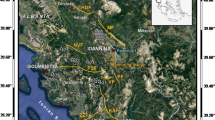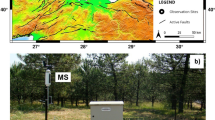Abstract
Radon is considered one of the short- and immediate-term earthquake precursors by International Association of Seismology and Physics of the Earth’s Interior. For this reason, the accurate and reliable measurement of its specific activity in soil gas is mandatory. Since its presence is influenced by many environmental factors, in order to eliminate this influence on the radon activity measurement a multi-parametric and multi-site analysis is necessary. Following this approach, a continuous radon monitoring was carried out in two sites of the Phlegrean Fields caldera (Campania, Italy) using the RaMonA system, which also allows for the measurement of temperature, relative humidity and pressure. In particular, the dependence of measured radon specific activity on the meteorological conditions was studied using the multiple linear regression method. The analysis was implemented also by testing data averages on different timescales. In this paper, the results of a preliminary analysis performed on data collected throughout 2012 are presented; the outcomes obtained allow to emphasize site-specific behavior and to discriminate apparent radon “anomalies” of climatic origin from those tied to the phenomena occurring in the earth’s crust. The method employed showed its usefulness by removing the effects of meteorological conditions and thus to better identify the possible radon anomalies caused by seismo-volcanic activity. The peculiarities of the different sites and some correlations with earthquakes are discussed.







Similar content being viewed by others
References
Barberi F, Innocenti F, Lirer L, Munno R, Pescatore T, Santacroce R (1978) The Campanian Ignimbrite: a major prehistoric eruption in the Neapolitan area (Italy). B Volcanol 41:10–31
Barbosa SM, Zafrir H, Malik U, Piatibratova O (2010) Multiyear to daily radon variability from continuous monitoring at the Amram tunnel. Southern Israel. Geophys J Int 182:829–842
Civetta L, Orsi G, Pappalardo L, Fisher RV, Heiken G, Ort M (1997) Geochemical zoning mingling eruptive dynamics and depositional processes—the Campanian Ignimbrite. Campi Flegrei caldera. Italy. J Volcanol Geotherm Res 75:183–219
D’Oriano C, Poggianti E, Bertagnini A, Cioni R, Landi P, Polacci M, Rosi M (2005) Changes in eruptive style during the AD 1538 Monte Nuovo eruption (Phlegrean Fields. Italy): the role of syn-eruptive crystallization. B Volcanol 67:601–621
De Cicco F, Pugliese M, Roca V, Sabbarese C, Avino R, Moretti R et al (2010) The application of the alpha spectrometry to the continuous radon monitoring in the soil gas: limits and perspectives. Dissertation, 10th international workshop on the geological aspects of radon risk mapping. Prague. September 2010
Di Vito M, Lirer L, Mastrolorenzo G, Rolandi G (1987) The 1538 Monte Nuovo eruption (Campi Flegrei. Italy). B Volcanol 49:608–615
Di Vito MA, Isaia R, Orsi G, Southon J, De Vita S, d’Antonio M et al (1999) Volcanism and deformation since 12,000 years at the Campi Flegrei caldera (Italy). J Volcanol Geotherm Res 91:221–246
Dobrovolsky IP, Zubkov SI, Miachkin VI (1979) Estimation of the size of earthquake preparation zones. Pure Appl Geophys 117:1025–1044
Garavaglia M, Dal Moro G, Zadro M (2000) Radon and tilt measurements in a seismic area: temperature effects. Phys Chem Earth Part A 25(3):233–237
Ghosh D, Deb A, Sengupta R (2009) Anomalous radon emission as precursor of earthquake. J Appl Geophys 69:67–81
Gregorič A, Zmazek B, Džeroski S, Torkar D, Vaupotič J (2011) Radon as an earthquake precursor-methods for detecting anomalies. In: Sebastiano D’Amico Dr (ed) Earthquake research and analysis-statistical studies, observations and planning. InTech, Trichy, pp 179–196
Iskandar D, Yamazawa H, Iida T (2004) Quantification of the dependency of radon emanation power on soil temperature. Appl Radiat Isot 60:971–973
Namvaran M, Negarestani A (2013) Measuring the radon concentration and investigating the mechanism of decline prior an earthquake (Jooshan. SE of Iran). J Radioanal Nucl Chem 298:1–8
Orsi G, De Vita S, Di Vito M (1996) The restless, resurgent Campi Flegrei nested caldera (Italy): constraints on its evolution and configuration. J Volcanol Geotherm Res 74:179–214
Parascandola A (1947) I fenomeni bradisismici del Serapeo di Pozzuoli. Stabilmento tipografico. G. Genovese, Chicago
Perrier F, Richon P, Crouzeix C, Morat P, Le Mouël JL (2004) Radon-222 signatures of natural ventilation regimes in an underground quarry. J Environ Radioact 71:17–32
Petraki E, Nikolopoulos D, Nomicos C, Stonham J, Cantzos D, Yannakopoulos P, Kottou S (2015) Electromagnetic pre-earthquake precursors: mechanisms. Data and models-a review. J Earth Sci Clim Change 6:250. doi:10.4172/2157-7617.1000250
Piochi M, Bruno PP, De Astis G (2005) Relative roles of rifting tectonics and magma ascent processes: inferences from geophysical structural volcanological and geochemical data for the Neapolitan volcanic region (southern Italy). Geochem Geophys. doi:10.1029/2004GC000885
Planinić J, Radolić V, Lazanin Ž (2001) Temporal variations of radon in soil related to earthquakes. Appl Radiat Isot 55(2):267–272
Roca V, Boiano A, Esposito A, Guardato S, Pugliese M, Sabbarese M, Venoso G (2004) A monitor for continuous and remote control of radon level and environmental parameters. Dissertation, nuclear science symposium conference record, October 2004 IEEE 3:pp 1563–1566
Venoso G, Pugliese M, Roca V, Sabbarese C (2009) A radon facility at Naples University: features and first tests. Appl Radiat Isot 67:863–866
Walia V, Virk HS, Yang TF, Mahajan S, Walia M, Bajwa BS (2005) Earthquake prediction studies using radon as a precursor in NW Himalayas. India: a case study. Terr Atmos Ocean Sci 16:775
Zoran M, Savastru R, Savastru D, Chitaru C, Baschir L, Tautan M (2012) Monitoring of radon anomalies in South-Eastern part of Romania for earthquake surveillance. J Radioanal Nucl Chem 293:769–781
Author information
Authors and Affiliations
Corresponding author
Rights and permissions
About this article
Cite this article
De Cicco, F., Pugliese, M., Quarto, M. et al. Multi-parametric approach to the analysis of soil radon gas for its validation as geoindicator in two sites of the Phlegrean Fields caldera (Italy). Environ Earth Sci 76, 317 (2017). https://doi.org/10.1007/s12665-017-6638-1
Received:
Accepted:
Published:
DOI: https://doi.org/10.1007/s12665-017-6638-1




